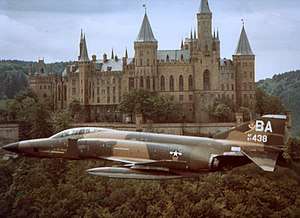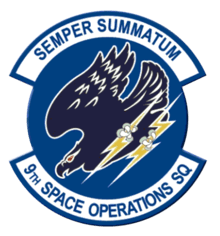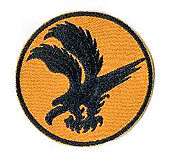9th Combat Operations Squadron
| 9th Combat Operations Squadron | |
|---|---|
 An RF-4 Phantom II from Bergstrom AFB flies by Hohenzollern Castle. Germany circa 1976 | |
| Active | 1943–1945; 1946–1947; 1953–1971; 1999–present |
| Country |
|
| Branch |
|
| Role | Space operations |
| Part of | Air Force Reserve Command |
| Garrison/HQ | Vandenberg AFB, California |
| Nickname(s) | Blackhawks |
| Motto(s) | Semper Summatum Latin Always the Highest |
| Engagements | European Theater of Operations[1] |
| Decorations |
Distinguished Unit Citation Air Force Outstanding Unit Award Air Force Organizational Excellence Award[1] |
| Insignia | |
| 9th Combat Operations Squadron emblem (approved 6 May 1999)[1] |
 |
| 9th Reconnaissance Squadron emblem (approved 14 October 1946)[2][note 1] |
 |
The United States Air Force's 9th Combat Operations Squadron, previously known as the 9th Space Operations Squadron, is a Air Force Reserve Command space operations unit located at Vandenberg Air Force Base, California. The 9th augments the 614th Air and Space Operations Center in operating the Joint Space Operations Center, or JSpOC, performing combat operations, plans, strategy and intelligence assessments that enable the Commander, Joint Functional Component Command for Space to command and control space forces by providing worldwide space effects and theater support to combatant commanders.
Mission
The 9th Combat Operations Squadron is a associate squadron to the 614th Air and Space Operations Center and augments the active duty center in day-to-day operations of the Joint Space Operations Center, a 24-hour operations center designed to provide commanders with assistance coordinating, planning, and conducting space operations.[3]
History
761st Bombardment Squadron
The unit was first activated as the 761st Bombardment Squadron on 1 July 1943;[2] and assigned to II Bomber Command for training with Consolidated B-24 Liberators. They primarily trained at Alamogordo Army Air Field, New Mexico and then moved to Kearns Army Air Base, Utah.
While at Kearns, the unit received deployment orders for the Mediterranean Theater of Operations in August 1943. However, its deployment location to Spinazzola Airfield, Italy was not constructed, so the unit spent a short time (Oct 1943-Jan 1944) at Chatham Army Air Field, Georgia flying coastal patrol missions over the southeastern United States.
The 761st at last deployed to Spinazzola Airfield in January 1944 and became part of the 55th Bombardment Wing under the 15th Air Force. Its mission was to conduct long-range strategic bombing sorties targeting enemy military and industrial transportation targets including railroad marshalling yards, oil refineries, airdromes, heavy industry and other strategic objectives in Italy, France, Germany, Austria, Hungary, Romania, and Yugoslavia.
The 761st flew its last World War II combat mission on 25 April 1945. After V-E Day, the squadron's mission changed to moving people under the Green Project. Their aircraft bomb bays were sealed, armament was removed, and the unit was reassigned to Air Transport Command. The squadron relocated to Waller Field, Trinidad and subsequently Parnamirim Airport, Brazil. The 761st moved people from Dakar in French West Africa to Brazil via the South Atlantic Transport Route with a final destination of Morrison Field, Florida. On 26 September 1945, the Green Project ended and the 761st was inactivated.
9th Reconnaissance Squadron
In 1946, the 761st was redesignated the 9th Reconnaissance Squadron and assigned to the 314th Composite Wing, of Twentieth Air Force, at Johnson Air Base and then Yokota Air Base, Japan.[2] 9th airmen flew the Bell P-39 Airacobra, as well as the Consolidated F-7 Liberator, Boeing F-9 Fkying Fortress, and Boeing F-13 Superfortress bombers retrofitted to perform photographic reconnaissance performing mapping missions over occupied Japan, Korea, Okinawa, Indochina, and other areas under Far East Air Forces' control after World War II. The squadron also flew classified missions over the Soviet Far East.
The squadron was inactivated in October 1947 and its personnel, equipment and mission were transferred to the 31st Reconnaissance Squadron.[2][4]
9th Tactical Reconnaissance Squadron
The squadron was reactivated on 11 November 1953 by Tactical Air Command (TAC) as the 9th Tactical Reconnaissance Squadron at Shaw Air Force Base, South Carolina, and fell under the 363d Tactical Reconnaissance Wing. It was initially equipped with Douglas RB-26 Invader light bombers equipped for night reconnaissance missions, and an example of this model, painted in the scheme of the 363d Wing, is on display at the entry of Shaw.
In January 1956, the squadron was the first in the Air Force to receive jet powered Douglas RB-66B Destroyers, which added weather sampling capability.[5] The unit later flew other upgraded models of the plane (RB-66C and WB-66D).[6]
In 1962, 9th had a Navy squadron commander, Commander Chester E. Kingsbury, and flew classified film missions supporting the Cuban Missile Crisis starting in October 1962. Between 1963 and 1966, 9th routinely deployed to Southeast Asia and served as an Air Force training squadron for the upgraded B-66 Destroyer.
On 31 Aug 1971, the 9th inactivated. The aircraft and crew were divided among units in Southeast Asia supporting the Vietnam War.
9th Space Operations Squadron
Since the early 1990s, the space command and control mission evolved and changed faster than anyone could have imagined. In 1994, 14th Air Force was activated at Vandenberg Air Force Base, California and became responsible for space operations. Between 1994 and 1998, United States Air Force reservists supported 14th Air Force on various man-day tours, primarily as individual mobilization augmentees. In 1999, Captain Pat Assayag led a team to discuss the possibility of activating a reserve squadron to support the 614th Space Operations Flight.
On 1 October 1999, the 9th Space Operations Squadron was activated as a reserve space operations squadron with 37 billets and the responsibility of supporting the newly redesignated 614th Space Operations Squadron to build the weekly Space Tasking Order. Many reservists supporting 14 Air Force were then reassigned to the 9th Squadron. At the unit activation ceremony, Major General Robert Hinson, commander of 14th Air Force, stated "our ability to maintain our nation's superiority in space is dependent upon the Air National Guard and Air Force Reserve as critical contributors to part of a cohesive Total Force."
In 2002, the space mission transferred from United States Space Command to United States Strategic Command, as Space Command inactivated. Then in 2003, Strategic Command's Joint Force Component Command was developed, and the Joint Space Operations Center was activated under the command's Space and Global Strike, which was soon redesignated JFCC SPACE.
In 2005, as the Fiscal Year 2008 Program Objective Memorandum was drafted, Air Force Space Command increased the squadron's manpower authorization from 37 to 126 billets, ensuring additional support to the 614th and the new 614th Space Intelligence Squadron. Also that year, the 1st Space Control Squadron moved to Vandenberg to become part of the 614th Space Operations Squadron. The 1st and 614th Space Operations Squadron combined to form the 614th Air and Space Operations Center in 2007.
In 2010, the command structure of 9 SOPS was adjusted to bring it more in line with the host 614 AOC's O-6 led command and division chief structure.
9th Combat Operations Squadron
On 3 June 2017, the 9th was redesignated in a formal ceremony as the 9th Combat Operations Squadron. This re-designation was done to follow the name standard of other reserve units associated with Air Operations Centers throughout the Air Force.
Today, the 9th is a growing unit of over 100 space, intelligence and communications professionals, expanding the vital role of support of the 614th and the JSpOC. Throughout many changes in personnel and mission, the 9th continues to be a strong backbone to Space Command and Control as well as space situational awareness missions at Vandenberg.[7]
Lineage
- Constituted as the 761st Bombardment Squadron (Heavy) on 19 May 1943
- Activated on 1 Jul 1943
- Redesignated 761st Bombardment Squadron, Heavy on 29 September 1944
- Inactivated on 26 September 1945
- Redesignated 9th Reconnaissance Squadron, Very Long Range, Photographic on 29 April 1946
- Activated on 20 June 1946
- Inactivated on 20 October 1947
- Redesignated 9th Tactical Reconnaissance Squadron, Electronics and Weather on 21 July 1953
- Activated on 11 November 1953
- Redesignated 9th Tactical Reconnaissance Squadron, Photo-Jet on 15 May 1965
- Redesignated 9th Tactical Reconnaissance Squadron on 1 October 1966
- Inactivated on 31 August 1971
- Redesignated 9th Space Operations Squadron on 5 February 1999
- Activated in the reserve on 1 October 1999[8]
- Redesignated 9th Combat Operations Squadron, 3 June 2017
Assignments
- 460th Bombardment Group, 1 July 1943 – 26 September 1945
- 314th Composite Wing, 20 June 1946 – 20 October 1947 (attached to 3d Bombardment Group c. 25 Sep 1946; 71st Reconnaissance Group, 22 April 1947; 3d Bombardment Group after 7 May 1947)
- 363d Tactical Reconnaissance Group, 11 November 1953
- 363d Tactical Reconnaissance Wing, 8 February 1958
- 4402d Tactical Training Group, 1 July 1966
- 363 Tactical Reconnaissance Wing, 1 February 1967
- 75th Tactical Reconnaissance Wing, 1 September 1969
- 67th Tactical Reconnaissance Wing, 15 July–31 August 1971
- 310th Space Group, 1 October 1999
- 310th Operations Group, 7 March 2008 – present[1]
Stations
- Alamogordo Army Air Field, New Mexico, 1 July 1943
- Kearns Army Air Base, Utah, 31 August 1943
- Chatham Army Air Field, Georgia, 29 October 1943 – 3 January 1944
- Spinazzola Airfield, Italy, c. 11 February 1944 – 6 June 1945
- Waller Field, Trinidad, 15 June 1945
- Parnamirim Airport, Brazil, 30 June 1945 – 26 September 1945
- Johnson Air Base, Japan, 20 June 1946
- Yokota Air Base, Japan, c. September 1946 - 20 October 1947
- Shaw Air Force Base, South Carolina, 11 Nov 1953
- Bergstrom Air Force Base, Texas, 1 Sep 1969 – 31 Aug 1971
- Vandenberg Air Force Base, California, 1 Oct 1999 – present[1]
Systems Operated
- Consolidated B-24 Liberator, 1943–1945
- Bell P-39 Airacobra, 1946–1947
- Consolidated F-7 Liberator, 1946–1947
- F-2, 1946-1947
- Boeing F-9 (later FB-17) Flying_Fortress, 1946–1947
- Boeing F-13 Superfortress, 1947
- Douglas RB-26 Invader, 1954–1956
- Lockheed RT-33 Shooting Star, 1955–1956
- Lockheed WT-33 Shooting Star, 1956
- North American TB-25 Mitchell, 1956
- Douglas RB-66 Destroyer, 1956–1966
- Douglas WB-66 Destroyer, 1957–1966[9]
- RF-4 Phantom II, 1965-1967, 1969-1971
- Functional (non-Falconer) Air Operations Center, 2000–Present[10]
References
Notes
- Explanatory notes
- ↑ The 31st Reconnaissance Squadron continued to use this emblem after it replaced the 9th at Yokota Air Base, rather than its own emblem, but it was not approved. Maurer, Combat Squadrons, pp. 152-153.
- Citations
- 1 2 3 4 5 Kane, Robert B. (December 27, 2010). "Factsheet 9 Space Operations Squadron (AFRC)". Air Force Historical Research Agency. Retrieved July 4, 2018.
- 1 2 3 4 Maurer, Combat Squadrons, pp. 741-742
- ↑ FAS.org: "Reserve activates two new space units"
- ↑ Maurer, Combat Squadrons, pp. 152-153
- ↑ Knaack, p. 419
- ↑ Knaack, p. 442, 452
- ↑ Details in this section were provided in private correspondence by the unit history record and published in an internal document for the redesignation ceremony in June 2017.
- ↑ Lineage through November 2010 in Kane.
- ↑ Lineage, including assignments, stations, and aircraft through 1963 in Maurer, Combat Squadrons, pp. 741-742
- ↑ World Airpower Journal. (1992). US Air Force Air Power Directory. Aerospace Publishing: London, UK. ISBN 1-880588-01-3
Bibliography
![]()
- Knaack, Marcelle Size (1988). Encyclopedia of US Air Force Aircraft and Missile Systems. Vol. 2, Post-World War II Bombers 1945-1973. Washington, DC: Office of Air Force History. ISBN 0-912799-59-5.
- Maurer, Maurer, ed. (1983) [1961]. Air Force Combat Units of World War II (PDF) (reprint ed.). Washington, DC: Office of Air Force History. ISBN 0-912799-02-1. LCCN 61060979. Retrieved December 17, 2016.
- Maurer, Maurer, ed. (1982) [1969]. Combat Squadrons of the Air Force, World War II (PDF) (reprint ed.). Washington, DC: Office of Air Force History. ISBN 0-405-12194-6. LCCN 70605402. OCLC 72556. Retrieved December 17, 2016.
- Ravenstein, Charles A. (1984). Air Force Combat Wings, Lineage & Honors Histories 1947-1977 (PDF). Washington, DC: Office of Air Force History. ISBN 0-912799-12-9. Retrieved December 17, 2016.
External links
- 9th Space Operations Squadron Unit Summary (retrieved 7 Jun 2017)
- 9th Space Operations Squadron Fact Sheet
